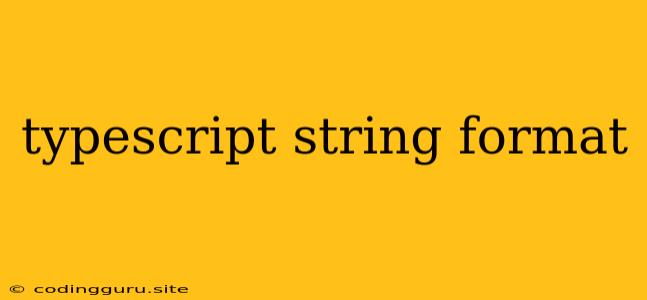Mastering String Formatting in TypeScript
TypeScript, with its strong typing system, provides powerful tools for manipulating and formatting strings. String formatting is crucial for creating readable, well-structured output, especially when dealing with data, logs, and user interfaces. This article explores how to effectively format strings in TypeScript, covering essential techniques and best practices.
Why is String Formatting Important in TypeScript?
Before diving into the techniques, let's understand why string formatting is crucial in TypeScript:
- Readability: Well-formatted strings make your code easier to read and understand, improving maintainability.
- Data Presentation: Formatting data into human-readable strings is essential for displaying information effectively, such as in user interfaces or logs.
- Dynamic Content: Formatting allows you to dynamically insert variables and expressions into strings, making your application more flexible.
Core Techniques for String Formatting in TypeScript
TypeScript offers several ways to format strings. Let's explore the most common approaches:
1. Template Literals (Backticks)
Template literals, enclosed in backticks ( ), provide the most straightforward way to format strings in TypeScript. They allow you to embed variables and expressions directly into the string.
const name = "Alice";
const age = 30;
const greeting = `Hello, my name is ${name} and I am ${age} years old.`;
console.log(greeting); // Output: Hello, my name is Alice and I am 30 years old.
Key Features of Template Literals:
- Expression Interpolation: You can embed any valid TypeScript expression within
${}. - Multi-line Strings: Template literals can span multiple lines without using escape characters.
- String Interpolation: Template literals also support interpolation within strings. For example,
\Hello, ${name}!``
2. String Concatenation (+)
The traditional method of string concatenation using the + operator remains a valid option.
const name = "Bob";
const message = "Welcome " + name + "!";
console.log(message); // Output: Welcome Bob!
When to Use Concatenation:
- Simple String Combining: For basic string combinations without complex expressions, concatenation can be concise.
3. String.prototype.replace()
The replace() method allows you to search for a pattern within a string and replace it with a new value.
const message = "The quick brown fox jumps over the lazy dog.";
const replacedMessage = message.replace("fox", "cat");
console.log(replacedMessage); // Output: The quick brown cat jumps over the lazy dog.
Key Points:
- Regular Expressions:
replace()supports regular expressions for more advanced pattern matching. - Global Replacement: Use the
gflag in the regular expression to replace all occurrences of the pattern.
4. String.prototype.split() and String.prototype.join()
These methods are useful for formatting strings by manipulating their parts.
Example: Converting a comma-separated string into an array of individual values.
const items = "apple, banana, cherry";
const itemArray = items.split(",");
const formattedList = itemArray.join(" - ");
console.log(formattedList); // Output: apple - banana - cherry
Explanation:
split(","): Splits the stringitemsinto an arrayitemArraybased on the comma delimiter.join(" - "): Joins the elements ofitemArrayusing a hyphen and space as the separator.
5. Custom Formatting Functions
For more complex formatting requirements, you can create your own functions.
Example: Formatting a number with leading zeros:
function formatNumberWithLeadingZeros(number, length) {
const str = number.toString();
return "0".repeat(length - str.length) + str;
}
const formattedNumber = formatNumberWithLeadingZeros(12, 5);
console.log(formattedNumber); // Output: 00012
Best Practices for String Formatting
- Template Literals First: Prioritize template literals for their ease of use and readability.
- Avoid String Concatenation for Complex Cases: While concatenation is straightforward, it can become cumbersome with multiple variables and expressions.
- Use Regular Expressions Carefully: Understand the power of regular expressions, but use them thoughtfully to avoid overly complex code.
- Create Reusable Formatting Functions: Extract common formatting logic into functions for code reuse and maintainability.
- Consistency is Key: Choose a formatting style and stick to it throughout your project for better code readability.
Conclusion
String formatting is an essential skill for TypeScript developers. Mastering these techniques allows you to create readable, structured output, enhancing the user experience and improving the maintainability of your code. Remember, the choice of technique depends on the complexity of your formatting requirements and the overall style of your project. With a solid understanding of TypeScript string formatting, you can effectively manipulate strings and present data in the best possible way.
